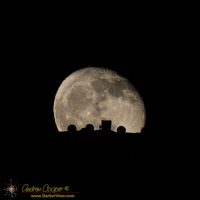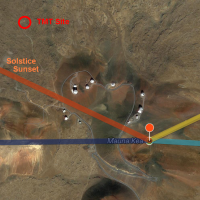During discussions concerning a previous posting another aspect of the video of Ms. Pisciotta became the subject of the conversation. For one familiar with the summit and the position of the features, the claims seem unlikely, something worth a closer look.
While I am singling out Ms. Pisciotta a bit here, she is a key figure in the opposition. She is a leader of Mauna Kea Anaina Hou, the most active opposition group and a primary participant in every significant legal case on the issue for the last several decades.
How can we examine this claim? From winter solstice, to equinox, to summer solstice, the position of sunrise and sunset changes significantly. This cycle has been tracked by shamans and priests for millennia, using the pattern to set the time of planting or religious ceremonies.
Many cultures constructed monuments specifically to allow this cycle to be tracked, aligned pillars, windows in buildings, carefully carved petroglyphs that align with shadows or beams of light. I have often visited sites like Chaco Canyon or Stonehenge specifically to note these alignments.
Ms. Piscotta’s claim seen here claim is very specific, and as such it can be verified fairly easily. All we need to do is plot the location of the sunset as seen from the summit throughout the year. Checking a map of the summit it becomes apparent we need not even do that, it is only the northern end of the path that comes close to any observatory, we need only check summer solstice.

Photographers use Photopills to plan sunrise and sunset, moonrise and moonset photos with surprising precision. I have done it myself, it works.
The application clearly indicates that sunset is not blocked as seen from the summit by any existing observatory. There may be some interference by the comparatively tiny Hoku Kea student telescope and its 16 foot dome, but this telescope is due to be removed.

Yes… Behind a hill, completely hidden from view, and 1.2 miles away. Yet TMT will somehow prevent the observation of the Sun.
Sunrise need not be checked, the true summit sits atop the eastern plateau, the eastern horizon is completely clear of any obstruction, unchanged since the last eruption tens of thousands of years ago.
In this sense the claims made here are typical of many claims made by telescope opponents. That somehow the construction of the telescopes will make religious practices impossible. And like this case the argument just does not pass any sort of examination, too many are simply false.
If you make the claim the entire summit is sacred, that is one thing. Instead we have claims like this, claims that are obviously false. The list of similar false claims is getting quite lengthy in this case, and as such do not help. Using religion as a legal criteria depends on an honest conversation from both sides. While the university and TMT corporation have been scrupulously accurate in their presentations, the other side? Not so much.
Certainly the telescopes have changed the summit, it is not the same place it was. The other summit users, from tourists wishing to watch sunset to families playing in the snow also change the environment. The presence of the facilities and other mountain users do not in any way prohibit religious practice.
Indeed, the observatories enable religious practices on the summit… The road to the summit was built for the observatories, and continues to be maintained using observatory funds. Without maintenance the road would become impassable within a few seasons of winter weather, or a single hurricane.

Historical accounts indicate that visits to the summit were quite rare, particularly after the mining of stone at the adze quarry ceased. Given the difficulty of access before construction of the road this is not surprise. It seems unlikely that religious practice at the summit was common in the way Ms. Piscotta claims, particularly through the 19th and early 20th centuries.
Ms. Piscotta’s assertion of tracking the Sun from the summit faces another criticism. From the summit of Mauna Kea the Sun sets into the featureless horizon of the distant Pacific Ocean. There are no landmarks by which to note the position of each sunset.
Other traditional skywatchers generally used fixed observing stations with a clear, preferably level horizon with prominent fixed features. If no features were available, they were often constructed.
Plotting the position of sunset is even more difficult as using sunset from the summit you must contend with the usual thick afternoon cloud cover, further obscuring the position of the setting Sun. Clear afternoons, when you can see the sea from the summit, are rare on the west side of the island. Thinking about it, in the many times I have watched, I have never seen a clear dawn either.
With the renewed cultural practices, increased tourism, and access via the observatory road, the summit has become a focus of activity. This is the reality that all summit users must acknowledge. The current OMKM management struggles with this issue, balancing access with preservation. Finding a balance between all those who wish to ascend Mauna Kea is possible. Easily demonstrated false claims are of no help in this effort.

